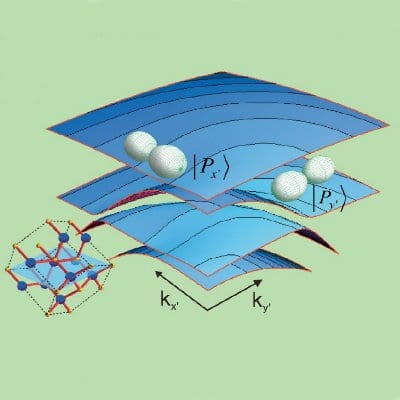 Since their first commercial success in bright blue light-emitting LEDs nearly 20 years ago, the group III nitrides have gained huge scientific and commercial interest, surpassing GaAs as the most important semiconductor material besides silicon. LEDs having internal quantum efficiencies beyond 80% at room temperature have been developed and are currently revolutionizing ambient lighting.
Since their first commercial success in bright blue light-emitting LEDs nearly 20 years ago, the group III nitrides have gained huge scientific and commercial interest, surpassing GaAs as the most important semiconductor material besides silicon. LEDs having internal quantum efficiencies beyond 80% at room temperature have been developed and are currently revolutionizing ambient lighting.
The high-brightness white LEDs used for solid-state-lighting are based on luminescence conversion of blue light emitters. However, when shifting the emission wavelength into the central visible range to obtain green light, we are faced with a strong decrease of the device efficiency, called the “green gap”. Moreover, LEDs typically experience a so-called “efficiency droop” for increasing current densities limiting their applicabilities for high-brightness lighting applications.
Today, both problems are thought to be caused to a large extent by the polar nature of GaN and its related heterostructures. In contrast to the conventional III–V compound semiconductors like GaAs, InP etc., the nitrides crystallize in wurtzitic, hexagonal symmetry. This gives rise to huge internal electric fields by spontaneous and piezoelectric polarization, the latter as a result of strain due to different lattice constants in typical device heterostructures. In principle, the size of such internal polarization fields depends on the main crystalline direction of the hetero interfaces. Hence, in the last years, a major world-wide research focus was put on studies how to realize non- and semipolar nitride-based heterostructures.
In Germany, several research groups have identified this problem at its very early stage and decided to launch a major cooperative scientific activity. The goals of this joint effort are related to both, basic physics and materials studies about polarity in semiconductors as well as applied investigations towards more efficient longer-wavelength light emitters, culminating in the terminus “green laser diode”. These activities have been financially supported for about three years by the Deutsche Forschungsgemeinschaft within the trans-regional research group “PolarCoN” (Polarization-Field Control in Nitride Light Emitters) where nine groups from eight German universities cooperate closely on these topics.
The collection of papers describes the technological challenges of epitaxially grown non- or semipolar nitride structures, followed by studies on the characteristics of such structures which also lead to novel band structure properties addressed in some modelling papers. Two Feature Articles with a focus on three-dimensional GaN and semi-polar interfaces and heterostructures, respectively, constitute the prologue. The last article of the series reviews the current status of green lasers and acts both as a benchmark for the research on this field and an outlook for the role which semipolar nitride light emitters may play for the green spectral region.
These excellent scientific results have now been published in a special section of physica status solidi (b) (Volume 248, Issue 3). All articles are freely available until 31 December 2011.

















